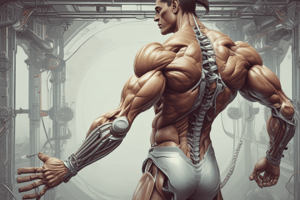Podcast
Questions and Answers
The load is the pivot point of a lever.
The load is the pivot point of a lever.
False (B)
What distinguishes the three different classes of levers found in the human body?
What distinguishes the three different classes of levers found in the human body?
where the components of the lever are located
The first class lever is the most common lever in the human body.
The first class lever is the most common lever in the human body.
False (B)
Swinging a tennis racket against a ball is an example of a third class lever.
Swinging a tennis racket against a ball is an example of a third class lever.
What is the difference between velocity and acceleration?
What is the difference between velocity and acceleration?
Second and third class levers both have __________.
Second and third class levers both have __________.
The ankle is a third class lever.
The ankle is a third class lever.
According to Newton's second law of motion, force is equal to mass times acceleration.
According to Newton's second law of motion, force is equal to mass times acceleration.
What lever has resistance between the axis (fulcrum) and the force (effort)?
What lever has resistance between the axis (fulcrum) and the force (effort)?
What is BEST to say about a runner who is running at a constant velocity?
What is BEST to say about a runner who is running at a constant velocity?
Flashcards are hidden until you start studying
Study Notes
Lever Classifications and Examples
- The pivot point of a lever is known as the fulcrum, not the load.
- Levers are distinguished by the arrangement of their components: the effort, fulcrum, and load.
- First-class levers are not the most common types found in the human body; examples include seesaws and some neck movements.
- Swinging a tennis racket represents a third-class lever, where the effort is applied between the fulcrum and the load.
Physics Principles
- Velocity and acceleration are distinct physical concepts; velocity refers to speed with direction, while acceleration measures the change in velocity.
- The ankle is classified as a second-class lever, contrary to the statement that it is a third-class lever.
- Newton's second law of motion asserts that force (F) equals mass (m) multiplied by acceleration (a), expressed as F = ma.
- A second-class lever features the resistance positioned between the fulcrum and the applied effort.
Motion Characteristics
- A runner maintaining a constant velocity will have zero acceleration, indicating no change in speed or direction.
Studying That Suits You
Use AI to generate personalized quizzes and flashcards to suit your learning preferences.




